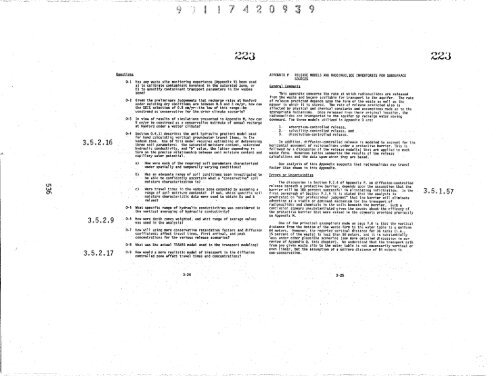EIS-0113_Section_11 - Hanford Site
EIS-0113_Section_11 - Hanford Site
EIS-0113_Section_11 - Hanford Site
You also want an ePaper? Increase the reach of your titles
YUMPU automatically turns print PDFs into web optimized ePapers that Google loves.
y<br />
^'<br />
d" ' w t¢ A 1 sd 93<br />
x<br />
45+23 6.423<br />
3.5.2.16<br />
Ooestions<br />
APPENDIX P RELEASE MODELS AND RADIONUCLIDE INVENTORIES FOR SUBSURFACE<br />
SOURCES<br />
0-1 Has any waste site monitoring experience (Appendix V) been used<br />
a) to calibrate contaminant movement in the saturatedzone, or General Co mm ents<br />
b) to quantify contaminant transport parameters in-the vadose<br />
zone?<br />
This appendix concerns the rate at which radionuclides are released<br />
from the waste and become available for trans port to the aquifer. The rate<br />
0.2 Given the preliminary judgements that recharge rates at <strong>Hanford</strong> of release predicted depends upon the form of the waste as well as the<br />
under existing dry conditions are between 0.5 and 5 cm/yr, how can manner in which it is stored. The rate of release predicted also is<br />
the D<strong>EIS</strong> selection of 0.5 cm/yr--the low of this range--be affected by physical and chemical constants and assumptions made as to the<br />
construed as conservative for the drier climate Scenario? appropriate mechanisms. Once released from their original location, the<br />
radionuclides are transported to the aquifer by recharge water moving<br />
0.3 In view of results of simulations p re sented in Appendix M, how can downward. The three models utilized in Appendix 0 are:<br />
5 cm/yr be construed as a conservative estimate of annual recharge<br />
at <strong>Hanford</strong> under a wetter climate?<br />
1. adsorption-controlled release,<br />
2.- solubility controlled release, and<br />
0-4 <strong>Section</strong> 0.4.<strong>11</strong> describes the unit hydraulic gradient model used<br />
-<br />
3. dissolution-controlled release.<br />
for hand calculating vertical g ro undwater travel times, in the<br />
vadose zone. Use of this model requi re s estimating or determining In addition, diffusion-controlled release is modeled to account for the<br />
three sail parameters:. the saturated moisture content, saturated horizontal movement of radionuclides under a protective harrier. This i<br />
hydraulic conductivity, and "b" value, the latter depending in followed by a discussion of the release model(s) that art applied to each<br />
.turn on the precise relationship between soil moisture content and waste form: Numerous tables summarize the results of the release<br />
capillary water potential. calculations and the data upon which they are based. -<br />
(Ti<br />
w<br />
Oh<br />
3.5.2.9<br />
3.5.2.17<br />
a) How were each of the required soil parameters characterized Our analysis of this Appendix suggests that radionuclides may travel<br />
under spatially and temporally varying conditions? faster than shown in this Appendix.<br />
b) Has an adequate range of soil conditions been investigated to Errors or Uncertainties<br />
be able re to confidently ascertain what a"censervative" soil<br />
- -<br />
moistu characterization is?<br />
The discussion in <strong>Section</strong> P.1..4 of Appendix P, on diffusion-controlled<br />
release th protective barrier, depends upon the assumption that the<br />
c) Were travel times in the vadose zone computed. by assuming a barrier done, will be 100 percent successful in eliminating infiltration, In the<br />
range of soil moisture contents? If not, which specific soil first . paragraph of <strong>Section</strong> P.1.4 it is stated that tha analysis is<br />
moisture characteristic data were used to obtain Ks and b predicated on "our professional judament' that the barrier will eliminate<br />
values?<br />
advection as viable or dominant Sache ism far the transport of<br />
- ` radionuclides and chemicals in the soils beneath the barrier. Such a<br />
0-5 What specific range of hydraulic conductivities was considered in conclusion appears unsubstantiated given the doubts about the efficacy of<br />
the vertical averaging of hydraulic conductivity? the protective barrier that were raised in the co mm ents provided previously<br />
on Appendix M.<br />
-<br />
0- 6 How were depth zones weighted, and what range of average values<br />
was used in the analysis?<br />
- - One of the principal assumptions madeon page is that the vertical<br />
distance from the bottom of the was" c to the water star<br />
a uniform<br />
0oei 4c<br />
i using more-conservative retardation factors-and diffusion<br />
1 5 meters. ofO the w the reported hart50 vertical istance for is tankst<br />
coefficcients affect travel times, first arrival, and peak le percent of the waste) is less than se meters, m and It is<br />
concentrations for the various release scenarios? less under other plausile scenarios see more detailed discussion fn our<br />
review of i eendfx p, this chapter). We understand<br />
the hat the<br />
transport path<br />
0-B What was

















